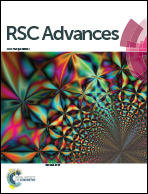Optimizing the prepared condition of TiO2 1D/3D network structure films to enhance the efficiency of dye-sensitized solar cells†
Abstract
A novel structure of TiO2 films has been successfully prepared on a fluorine-doped tin oxide (FTO) glass substrate through a feasible two-step hydrothermal method. In the first-step hydrothermal growth results in one-dimensional (1D) rutile TiO2 nanorod arrays capped by 3 dimensional (3D) rutile TiO2 nanorods, and in the second-step hydrothermal etching in hydrochloric acid solution leads to the selective etching of 3D TiO2 nanorods to form 3D nanotubes at first, and then the tip wall of the nanotubes divide into secondary nanowires with reduced diameters. The resultant bi-layer TiO2 network structure films were used as photoanodes in dye-sensitized solar cells (DSSCs). The 3D rutile network structure provides a large surface area for dye-loading and the oriented nanorod arrays at the bottom layer enable a direct pathway for electron transport. The influence of etching time toward the photovoltaic performance of the DSSCs fabricated from TiO2 network structure films has been comprehensively studied. It was found that the amount and the length of the secondary nanowires reached a maximum when the etching time was 14 h, which resulted in the largest surface area and best dye-loading ability of the TiO2 network structure films, producing an overwhelming power conversion efficiency (PCE) of 5.71%. In addition, TiCl4 post-treatment was employed to further improve the PCE. Through optimizing the amount of the titanium precursor and the time of TiCl4 treatment, the DSSCs assembled with a TiO2 1D/3D network structure photoanode presented a markedly enhanced efficiency of 7.68%, when the TiO2 films were synthesized with 0.9 ml tetrabutyl titanate followed by 12 h etching and treated with TiCl4 for 48 h.


 Please wait while we load your content...
Please wait while we load your content...